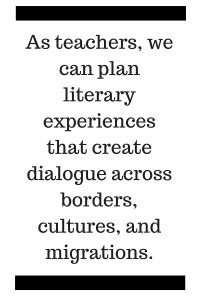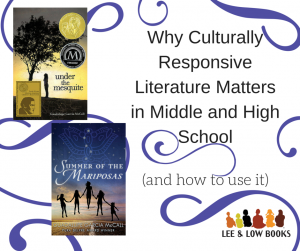
![]() In this interview with The Open Book, guest blogger R. Joseph Rodríguez, Assistant Professor of Literacy and English Education at The University of Texas at El Paso, shares strategies on teaching Guadalupe García McCall’s novels in middle and high school English Language Arts, as well as discusses the impact of culturally responsive and relevant literature in the classroom.
In this interview with The Open Book, guest blogger R. Joseph Rodríguez, Assistant Professor of Literacy and English Education at The University of Texas at El Paso, shares strategies on teaching Guadalupe García McCall’s novels in middle and high school English Language Arts, as well as discusses the impact of culturally responsive and relevant literature in the classroom.
What inspired you to write about Guadalupe García McCall, her literature, and classroom applications?
Guadalupe García McCall’s writings create many connections and destinations in my life, crossing many geographies and memories across time—from my growing up to today. As I read her books, I travel in conversation with her characters.
In literature, we enact the elements of storytelling and literacy by becoming involved with all the facets that make a story readable, understandable, relatable, and enjoyable.
The worlds García McCall creates in her literary works mirror my childhood and journeys. Specifically, Piedras Negras, Coahuila, México, where García McCall was born, is the home of my maternal aunt Cristina, uncle Andrés, and cousins. While growing up, my parents, siblings, and I traveled from Houston to visit them.
Like in García McCall’s novels and poems, many families and cultures are before us—en vivo and in print—with storytellers and cuentos crossing the national grids of the U.S. and México borderlands.
For teachers interested in using Summer of the Mariposas and/or Under the Mesquite—what would you recommend they use the texts for? What part of curriculum? What could they pair this with—any literature or primary source documents?
The novel in verse Under the Mesquite meets various standards in English language arts that include poetry and various literary elements as well as other disciplines. The book presents an adolescent female who creates poetry and dramatic performances, supports her siblings as a caring problem solver, and seeks ways to keep her mother’s memory alive. The text can be paired with other novels in verse that feature characters with dilemmas and choices that lead to trials and triumphs.
Several primary sources can be considered such as the literary works within the novel, diaries and ballads with historical and personal accounts, and excerpts from classics and contemporary classics that feature first-person point of view such as A Good Long Way, American Ace, Brown Girl Dreaming, CrashBoomLove, My Own True Name, Locomotion, and Republic, among others.
How do you think Under the Mesquite or Summer of the Mariposas could be used to support student writing? What student work or output could teachers have students create to demonstrate understanding?
As teachers, we can welcome diverse voices in our classrooms and students’ lives by allowing characters to move from the page to other media: performing and visual arts. Reading García McCall’s novels and poetry remind us of the varied stories we carry with our families and in our interior—alive and in memory.
We carry these stories beyond our own biological families to the literary characters and families we meet through the mirrors, windows, and doors of their lives created by our author and medium García McCall and our very own lives. Student can write about these memories with an image that launches the conversation to a recording that can create a collage of storytelling with varied techniques and improvisation for the classroom stage.
 There are no required texts for the Common Core State Standards, but we still see that schools and districts can be shy to branch out from more classic texts (“classics” as in texts that seem to appear in every high school year in year out as well as many that are Caucasian and European American literary canon). Why do you think that is? What can teachers do to include more contemporary and/or culturally responsive and relevant texts with limited time and flexibility in the year and curriculum?
There are no required texts for the Common Core State Standards, but we still see that schools and districts can be shy to branch out from more classic texts (“classics” as in texts that seem to appear in every high school year in year out as well as many that are Caucasian and European American literary canon). Why do you think that is? What can teachers do to include more contemporary and/or culturally responsive and relevant texts with limited time and flexibility in the year and curriculum?
Becoming aware of the civic communities that border our schools, the cultural resources and references that inform ideas and decisions, and students’ everyday resilience are key insights to create community through literature and even transport readers to other places in time, to the present, and toward the future.
As teachers, we can also plan literary experiences that create dialogue across borders, cultures, and migrations. Our lessons can reflect adventure, drama, choice, conflict, dilemma, and triumph experienced by characters through literature from diverse experiences, places, and realities. This requires deliberate planning with concepts and competencies for culturally responsive and sustaining instruction that places classics and contemporary classics in dialogue with deeper learning, thinking, and questioning.
Lastly, through the guidance of their teachers, many students are book borrowers who experience libraries in classrooms, schools, homes, and civic communities. As a result, students are permitted self-selection of both print books and e-books.
Is it enough to select a “culturally responsive” book for the curriculum? What does culturally responsive and relevant instruction look like? How can high school teachers make the whole process from book selection, introduction, instruction, and student work/output culturally responsive and relevant?
When I found García McCall’s novels, which were recommended by Pat Mora, I heard the familiar voices come alive and the stories speak to me from the print and digital pages of our national and binational literary canons. Culture is really about imagination and knowledge and how these sustain us as communities. Thus, as teachers we must be in conversation with our teaching colleagues as well as readers who are among us: our students, their families, librarians, and critics.
There are several book awards that can inform our literary selection and introduction. For instruction and student work, we can rely on resources from the American Library Association, Edutopia, ReadWriteThink.org, and publications from ILA and NCTE. Moreover, the process for selecting a book can take into consideration teaching standards and student learning outcomes that promote growth with interdisciplinary thinking and learning.
Teachers interested in the inclusion of diverse literary traditions understand the role of reading, writing, authorship, and representation in the literacy classroom. The research informs us that students seek literary characters and favor reading and writing experiences that reflect their life choices and questions in both public and private spaces. These choices and questions can be explored through both classics and contemporary classics.
 What is at stake if educators do not include culturally responsive and relevant works like García McCall in middle and high school classrooms?
What is at stake if educators do not include culturally responsive and relevant works like García McCall in middle and high school classrooms?
What is at stake here is our democracy and shared efforts for global world understanding. Like García McCall and her characters reveal, we barter through world languages and literature. As a result, we have examples of human cultures meeting and sharing in the making of civilizations, languages, and stories. My earliest memories of family gatherings reflect bilingualism and biculturalism with biliteracies bringing us the warmth and energy to express ourselves so freely and with laughter and occasionally some of life’s sorrows.
Partly driven by fear and also by limited access to print and marketing, diverse voices were missing in textbooks and shelves across the country. This is changing as the U.S. mirrors more who its inhabitants have been: a country of diverse citizens with shared values about literacy and learning. We cannot succumb to fear with non-publication and non-participation if we are to keep our reading public alive for democracy to survive.
I remember the great importance placed on attendance in my schooling. In retrospect, many went uncounted and unaccounted for in my schooling: the literary characters who could forge new ways of seeing, reading, and interpreting adolescent life and thought, yet remained absent. That need not happen any longer as we rethink language arts and literacy education. Our teaching profession calls us to be committed to social change, reflection, and action by bringing more literacy opportunities into the lives of our students—of all ages, abilities, backgrounds, colors, and reading interests—and their diverse communities.
Joseph Rodríguez is Assistant Professor of Literacy and English Education at The University of Texas at El Paso, located on the border across from Ciudad Juárez, Chihuahua, México. His research interests include children’s and young adult literatures, socially responsible biliteracies, and academic writing. Catch him virtually @escribescribe or via email: rjrodriguez6@utep.edu.
For further reading by R. Joseph Rodríguez:
- “Guadalupe García McCall: A Storyteller of Cultures and Odysseys” by Joseph Rodríguez and KaaVonia Hinton in SIGNAL journal, the Journal of the International Reading Association’s Special Interest Group: Network on Adolescent Literature
- “‘I Knew What I Had to Do Next’: Writing (and Reading) Middle Graders’ Lives” by Joseph Rodríguez in English in Texas, a Journal of the Texas Council of Teachers of English Language Arts
 Under the Mesquite:
Under the Mesquite:
- Under the Mesquite by Guadalupe Garcia McCall
- Discussion questions for Under the Mesquite from LEE & LOW BOOKS
- Educator’s Guide for Under the Mesquite from Vamos A Leer at the Latin American & Iberian Institute (LAII)
- Lesson Plan from the Association for Library Service to Children’sDía Family Book Club Curriculum
- Using Under the Mesquite to teach close reading from LEE & LOW BOOKS
- Interview with Guadalupe Garcia McCall on Under the Mesquite
- “On How Writing Heals”—essay from Guadalupe Garcia McCall
Summer of the Mariposas:
- Summer of the Mariposas by Guadalupe Garcia McCall
- Discussion questions for Summer of the Mariposas from LEE & LOW BOOKS
- Educator’s Guide for Under the Mesquite from Vamos A Leer at the Latin American & Iberian Institute (LAII)
- Interview with Guadalupe Garcia McCall on Summer of the Mariposas
Guadalupe García McCall:








